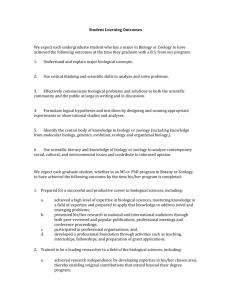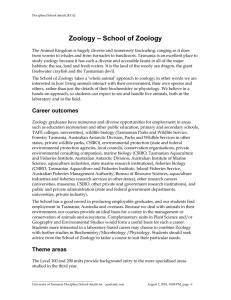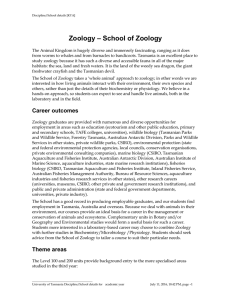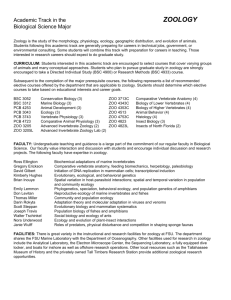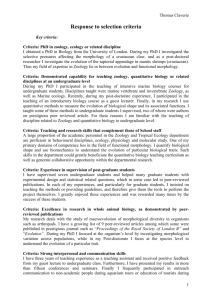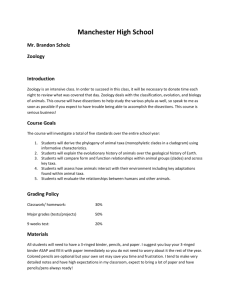KZA - University of Tasmania
advertisement
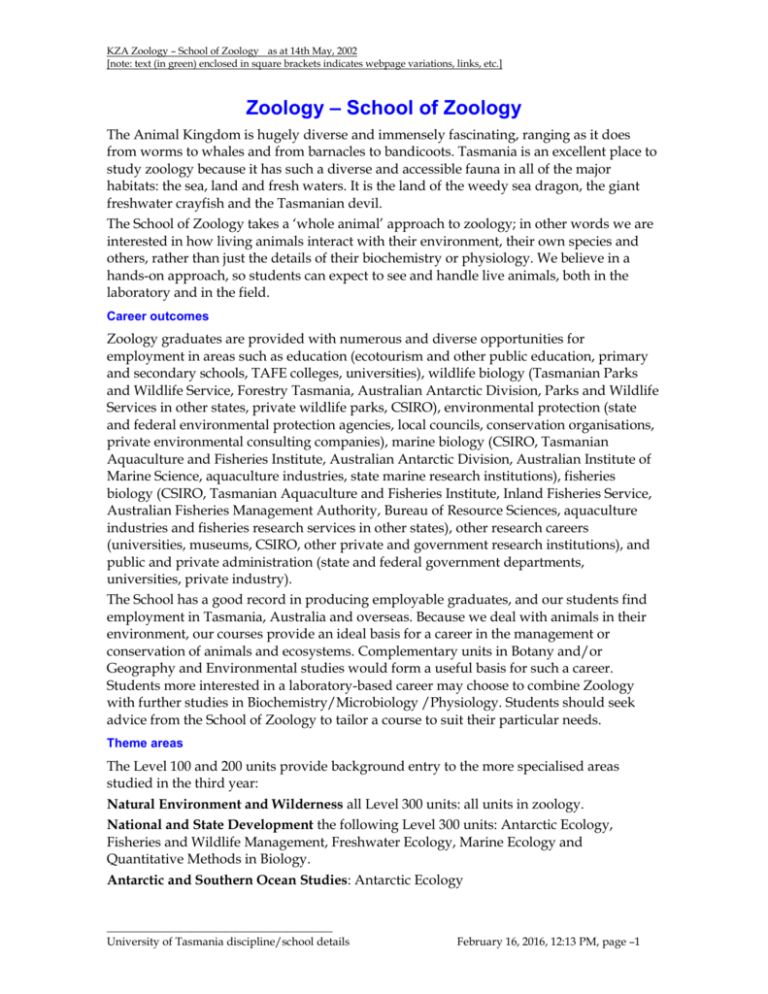
KZA Zoology – School of Zoology as at 14th May, 2002 [note: text (in green) enclosed in square brackets indicates webpage variations, links, etc.] Zoology – School of Zoology The Animal Kingdom is hugely diverse and immensely fascinating, ranging as it does from worms to whales and from barnacles to bandicoots. Tasmania is an excellent place to study zoology because it has such a diverse and accessible fauna in all of the major habitats: the sea, land and fresh waters. It is the land of the weedy sea dragon, the giant freshwater crayfish and the Tasmanian devil. The School of Zoology takes a ‘whole animal’ approach to zoology; in other words we are interested in how living animals interact with their environment, their own species and others, rather than just the details of their biochemistry or physiology. We believe in a hands-on approach, so students can expect to see and handle live animals, both in the laboratory and in the field. Career outcomes Zoology graduates are provided with numerous and diverse opportunities for employment in areas such as education (ecotourism and other public education, primary and secondary schools, TAFE colleges, universities), wildlife biology (Tasmanian Parks and Wildlife Service, Forestry Tasmania, Australian Antarctic Division, Parks and Wildlife Services in other states, private wildlife parks, CSIRO), environmental protection (state and federal environmental protection agencies, local councils, conservation organisations, private environmental consulting companies), marine biology (CSIRO, Tasmanian Aquaculture and Fisheries Institute, Australian Antarctic Division, Australian Institute of Marine Science, aquaculture industries, state marine research institutions), fisheries biology (CSIRO, Tasmanian Aquaculture and Fisheries Institute, Inland Fisheries Service, Australian Fisheries Management Authority, Bureau of Resource Sciences, aquaculture industries and fisheries research services in other states), other research careers (universities, museums, CSIRO, other private and government research institutions), and public and private administration (state and federal government departments, universities, private industry). The School has a good record in producing employable graduates, and our students find employment in Tasmania, Australia and overseas. Because we deal with animals in their environment, our courses provide an ideal basis for a career in the management or conservation of animals and ecosystems. Complementary units in Botany and/or Geography and Environmental studies would form a useful basis for such a career. Students more interested in a laboratory-based career may choose to combine Zoology with further studies in Biochemistry/Microbiology /Physiology. Students should seek advice from the School of Zoology to tailor a course to suit their particular needs. Theme areas The Level 100 and 200 units provide background entry to the more specialised areas studied in the third year: Natural Environment and Wilderness all Level 300 units: all units in zoology. National and State Development the following Level 300 units: Antarctic Ecology, Fisheries and Wildlife Management, Freshwater Ecology, Marine Ecology and Quantitative Methods in Biology. Antarctic and Southern Ocean Studies: Antarctic Ecology ________________________________________ University of Tasmania discipline/school details February 16, 2016, 12:13 PM, page –1 KZA Zoology – School of Zoology as at 14th May, 2002 [note: text (in green) enclosed in square brackets indicates webpage variations, links, etc.] Professional associations Ecological Society of Australia; Ecological Society of America; Australian Mammal Society; Australian Herpetological Society; Australian Society of Comparative Endocrinology; Australian Marine Sciences Association; Australian Society of Fish Biology; Australia New Zealand Society for Comparative Physiology and Biochemistry; Australian Institute of Biologists; Australian Society of Phycology and Aquatic Botany; Australian Society of Reproductive Biology; Australian Society of Limnology; Society of Behavioural and Neuroendocrinology; Royal Society of Tasmania; Marine Mammal Society; Birds Australia. Unit title campus-sem weight code First Year *KZA150 or *KZA151 KZA150 Zoology 1G H.6, 25% KZA151 Zoology 1E H.6, 25% and other units to a total of 100% from other Group 1 areas in the life, earth, physical and numerical sciences (see BSc schedule on page B-xx. Students proposing to major in zoology are strongly urged to include physical (chemistry or physics) or numerical (mathematics or computer science) science units in their first year program. Note: Students also enrolling in or having previously passed *KPA150 Botany IG must enrol in *KZA151 Zoology 1E. Students proposing to study Biochemistry and/or Microbiology in Year 2 must enrol in *KZA150 Zoology IG if they are not currently enrolling in or have not previously passed *KPA150 Botany 1G. Second Year KZA205 Zoology 2: Animal H.6, 25% Form & Function and 75% from other units of a student’s own choice, including: KZA215 Tasmanian Fauna: H.1, 12.5% Ecological & Evolutionary Studies KZA225 or KZA325 Evolution, Ecology H.2, 12.5% & Society Third Year KZA351 Antarctic Ecology H.2, 12.5% KZA352 Environmental H.2, 12.5% Adaptation KZA353 Evolutionary H.2, 12.5% Biology & Biogeography KZA354 Fisheries & Wildlife H.1, 12.5% Management KZA355 Freshwater Ecology H.2, 12.5% KZA356 Marine Ecology H.1, 12.5% KZA357 Quantitative H.1, 12.5% Methods in Biology KZA358 Reproductive H.1, 12.5% ________________________________________ University of Tasmania discipline/school details February 16, 2016, 12:13 PM, page –2 KZA Zoology – School of Zoology as at 14th May, 2002 [note: text (in green) enclosed in square brackets indicates webpage variations, links, etc.] Biology: Strategies and Mechanisms Students interested in marine, freshwater or Antarctic biology should read the course entry Marine, Freshwater and Antarctic Biology (see page B-xx). ________________________________________ University of Tasmania discipline/school details February 16, 2016, 12:13 PM, page –3
